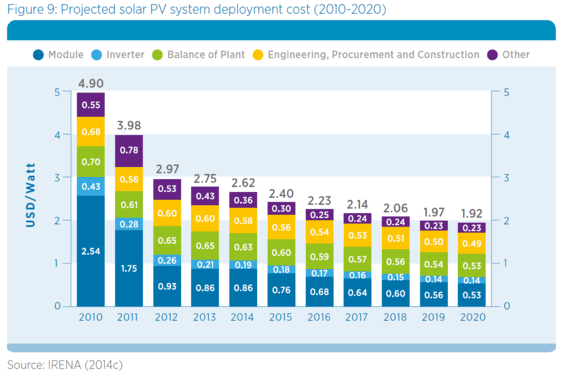In its report entitled REthinking Energy 2014 (PDF), the International Renewable Energy Agency (IRENA) produces a very useful set of overviews, essentially showing that renewable energy will continue to become less expensive up to 2020. For photovoltaics, the organization has produced a few especially interesting charts.
Here, we see that the price of turnkey PV is expected to drop by roughly another fifth from now until 2020 (though it would have been nice to have future years marked as estimates, such as “2015e”). The panels themselves will continue to become cheaper, as will “other,” which essentially signifies “soft costs.” As I explained two years ago, this cost item is a major factor when trying to explain the difference in PV prices from one country to another – but more on that later.
Another salient finding is the roughly 60 percent decrease in solar panel prices from 2010 to 2012, and the cost of inverters also dropped roughly in half from 2010 to 2013, though that item makes up a smaller share of the pie. Overall, the cost of an installed array fell by some 40 percent from 2010 to 2012.
There are, however, two opposite movements for which no explanation is provided. First, “other” rose significantly from 2010 to 2011; second, “engineering” is apparently now more expensive than it was in 2011. There may be a silver lining to that second item though; it largely represents well-paid labor. In other words, PV makes for good jobs.
Another chart shows the difference that soft costs make. In a comparison of array prices in Germany and the US, it turns out that balance-of-system costs are easily twice as high in the US, while panel prices are nearly the same. This finding is in line with other previous reports.
Finally, there is a chart on the cost of a German array relative to the feed-in tariffs offered. Once again, we have clear evidence that far more than the target return of six percent was available roughly from 2009-2011; the reductions in feed-in tariffs for PV were sorely needed. In return, it seems that new solar arrays in Germany are no longer profitable at all – indeed, they apparently have not been since the beginning of 2013. This finding is a bit surprising for last year; after all, 3.8 GW was still installed. But the data do help explain the much slower market in 2014.
While that final chart is for systems smaller than 10 kilowatts, the other charts do lump together systems of different sizes – a useful simplification for the overall message, though the actual cost of PV varies considerably from small rooftop arrays to large utility-scale systems in the field.
It is worth adding that the itemization above is often done with an eye to local content requirements. The overall message could be that there is a lot of local added value even if solar panels themselves are imported. As an international agency representing developed, emerging, and developing countries alike, IRENA takes a more cautious stance, arguing that local content requirements (LCRs) are fine as temporary mechanisms, but we should not forget the importance of PV as a global industry: “To ensure the full-fledged development of an infant industry, LCRs should be time-bound, closely linked to a learning-by-doing process, and support the creation of an internationally-competitive domestic industry with a skilled workforce.”
Source: Renewables International. Reproduced with permission.










